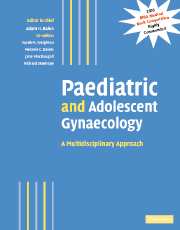Book contents
- Frontmatter
- Contents
- Contributors
- Preface
- Part I Normal development
- 1 Embryology of the female genital tract
- 2 Molecular genetics of gonad development
- 3 Gonadotrophin receptors
- 4 Normal childhood, puberty and adolescence
- 5 Control of the menstrual cycle and fertility
- 6 Nutrition and reproductive function
- 7 Normal bladder control and function
- 8 Development of sexuality: psychological perspectives
- Part II Management of developmental abnormalities of the genital tract
- Part III Management of specific disorders
- Index
- Plate section
- References
4 - Normal childhood, puberty and adolescence
from Part I - Normal development
Published online by Cambridge University Press: 04 May 2010
- Frontmatter
- Contents
- Contributors
- Preface
- Part I Normal development
- 1 Embryology of the female genital tract
- 2 Molecular genetics of gonad development
- 3 Gonadotrophin receptors
- 4 Normal childhood, puberty and adolescence
- 5 Control of the menstrual cycle and fertility
- 6 Nutrition and reproductive function
- 7 Normal bladder control and function
- 8 Development of sexuality: psychological perspectives
- Part II Management of developmental abnormalities of the genital tract
- Part III Management of specific disorders
- Index
- Plate section
- References
Summary
Introduction
Sex determination, or genetic sex, is a process starting at conception by which the undifferentiated genitalia evolve into male or female reproductive organs. It depends on chromosomal complement and is influenced by endocrine events and by nongenetic and nonendocrine factors such as nutrition, toxins (fetal alcohol syndrome), intrauterine environment (altered uterine blood flow, placental function, local uterine circulation and placental and umbilical circulation).
Initially this cascade of events is dependent on chromosomal or genetic sex, and then appropriate development of the hypothalamic—pituitary—gonadal axis is necessary for sex steroid secretion as well as for oogenesis and ovulation in the female and spermatogenesis in the male.
Genotype and phenotype
Genetic sex directs the embryonic gonad to differentiate into either testis or ovary and is determined by the presence or the absence of the Y chromosome.
The sex-determining region of the Y chromosome (SRY) has been mapped to the tip of the Y chromosome (Parker et al., 1999) and has been shown to be necessary and sufficient to initiate the male differentiation pathway and acts as a genetic switch towards testis development. If it is absent (or delayed in expression), ovarian differentiation occurs. However, many other factors involved in sex differentiation have been identified and are located on autosomal genes. In the presence of “male differentiating signals”, testosterone and Müllerian inhibiting factor (anti-Müllerian hormone (AMH) or Müllerian inhibiting substance) are secreted by the fetal gonads. Testosterone is converted to dihydrotestosterone by the 5α-reductase enzyme in target tissues.
- Type
- Chapter
- Information
- Paediatric and Adolescent GynaecologyA Multidisciplinary Approach, pp. 44 - 50Publisher: Cambridge University PressPrint publication year: 2004
References
- 4
- Cited by



